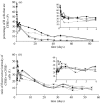Quantifying lymphocyte kinetics in vivo using carboxyfluorescein diacetate succinimidyl ester (CFSE)
- PMID: 16600897
- PMCID: PMC1560268
- DOI: 10.1098/rspb.2005.3432
Quantifying lymphocyte kinetics in vivo using carboxyfluorescein diacetate succinimidyl ester (CFSE)
Abstract
The cytoplasmic dye carboxyfluorescein diacetate succinimidyl ester (CFSE) is used to quantify cell kinetics. It is particularly important in studies of lymphocyte homeostasis where its labelling of cells irrespective of their stage in the cell cycle makes it preferable to deuterated glucose and BrdU, which only label dividing cells and thus produce unrepresentative results. In the past, experiments have been limited by the need to obtain a clear separation of CFSE peaks forcing scientists to adopt a strategy of in vitro labelling of cells followed by their injection into the host. Here we develop a framework for analysis of in vivo CFSE labelling data. This enables us to estimate the rate of proliferation and death of lymphocytes in situ, and thus represents a considerable advance over current procedures. We illustrate this approach using in vivo CFSE labelling of B lymphocytes in sheep.
Figures




Similar articles
-
The use of carboxyfluorescein diacetate succinimidyl ester (CFSE) to monitor lymphocyte proliferation.J Vis Exp. 2010 Oct 12;(44):2259. doi: 10.3791/2259. J Vis Exp. 2010. PMID: 20972413 Free PMC article.
-
Carboxyfluorescein diacetate succinimidyl ester and the virgin lymphocyte: a marriage made in heaven.Immunol Cell Biol. 1999 Dec;77(6):530-8. doi: 10.1046/j.1440-1711.1999.00871.x. Immunol Cell Biol. 1999. PMID: 10571674 Review.
-
Divided we stand: tracking cell proliferation with carboxyfluorescein diacetate succinimidyl ester.Immunol Cell Biol. 1999 Dec;77(6):509-15. doi: 10.1046/j.1440-1711.1999.00864.x. Immunol Cell Biol. 1999. PMID: 10571671 Review.
-
New and improved methods for measuring lymphocyte proliferation in vitro and in vivo using CFSE-like fluorescent dyes.J Immunol Methods. 2012 May 31;379(1-2):1-14. doi: 10.1016/j.jim.2012.02.012. Epub 2012 Feb 21. J Immunol Methods. 2012. PMID: 22370428
-
Analysing cell division in vivo and in vitro using flow cytometric measurement of CFSE dye dilution.J Immunol Methods. 2000 Sep 21;243(1-2):147-54. doi: 10.1016/s0022-1759(00)00231-3. J Immunol Methods. 2000. PMID: 10986412 Review.
Cited by
-
Spleen-dependent turnover of CD11b peripheral blood B lymphocytes in bovine leukemia virus-infected sheep.J Virol. 2006 Dec;80(24):11998-2008. doi: 10.1128/JVI.01447-06. Epub 2006 Oct 11. J Virol. 2006. PMID: 17035334 Free PMC article.
-
Peripheral blood B-cell death compensates for excessive proliferation in lymphoid tissues and maintains homeostasis in bovine leukemia virus-infected sheep.J Virol. 2006 Oct;80(19):9710-9. doi: 10.1128/JVI.01022-06. J Virol. 2006. PMID: 16973575 Free PMC article.
-
Quantifying T lymphocyte turnover.J Theor Biol. 2013 Jun 21;327:45-87. doi: 10.1016/j.jtbi.2012.12.025. Epub 2013 Jan 9. J Theor Biol. 2013. PMID: 23313150 Free PMC article.
-
Interpreting CFSE obtained division histories of B cells in vitro with Smith-Martin and cyton type models.Bull Math Biol. 2009 Oct;71(7):1649-70. doi: 10.1007/s11538-009-9418-6. Epub 2009 Apr 21. Bull Math Biol. 2009. PMID: 19381725 Free PMC article.
-
Mechanisms of leukemogenesis induced by bovine leukemia virus: prospects for novel anti-retroviral therapies in human.Retrovirology. 2007 Mar 16;4:18. doi: 10.1186/1742-4690-4-18. Retrovirology. 2007. PMID: 17362524 Free PMC article. Review.
References
-
- Asquith B, Debacq C, Macallan D.C, Willems L, Bangham C.R. Lymphocyte kinetics: the interpretation of labelling data. Trends Immunol. 2002;23:596–601. 10.1016/S1471-4906(02)02337-2 - DOI - PubMed
-
- De Boer R.J, Mohri H, Ho D.D, Perelson A.S. Estimating average cellular turnover from 5-bromo-2′-deoxyuridine (BrdU) measurements. Proc. R. Soc. B. 2003a;270:849–858. 10.1098/rspb.2002.2299 - DOI - PMC - PubMed
-
- De Boer R.J, Mohri H, Ho D.D, Perelson A.S. Turnover rates of B cells, T cells, and NK cells in simian immunodeficiency virus-infected and uninfected rhesus macaques. J. Immunol. 2003b;170:2479–2487. - PubMed
-
- Debacq C, Asquith B, Kerkhofs P, Portetelle D, Burny A, Kettmann R, Willems L. Increased cell proliferation, but not reduced cell death, induces lymphocytosis in bovine leukemia virus-infected sheep. Proc. Natl Acad. Sci. USA. 2002;99:10 048–10 053. 10.1073/pnas.142100999 - DOI - PMC - PubMed
Publication types
MeSH terms
Substances
LinkOut - more resources
Full Text Sources
Other Literature Sources
Molecular Biology Databases
Miscellaneous

